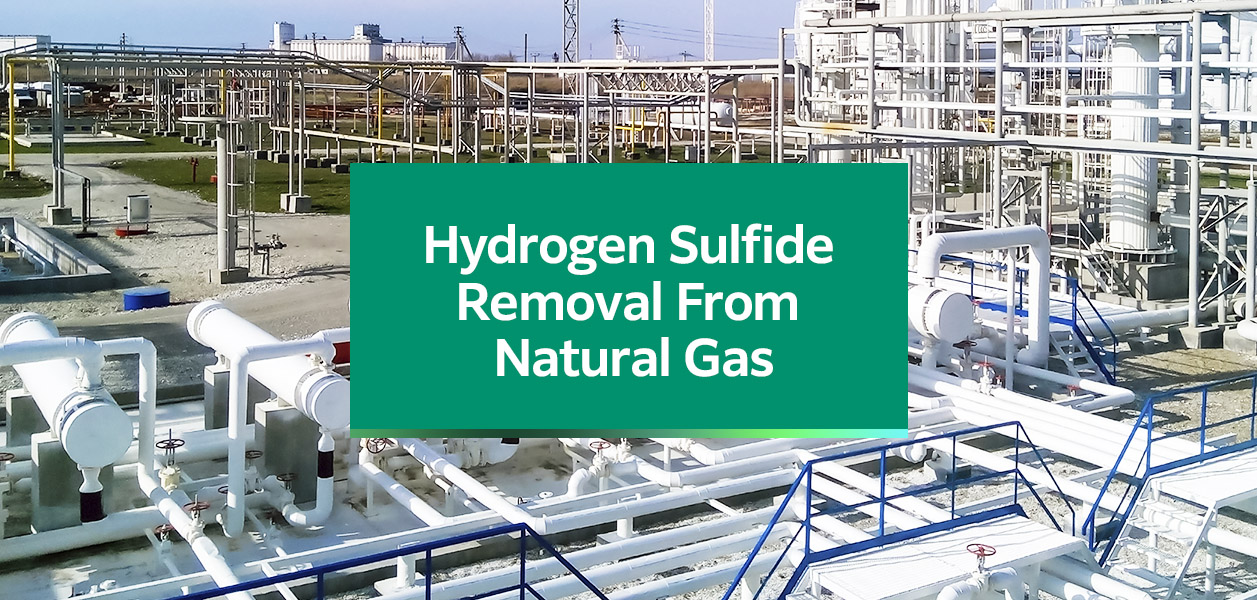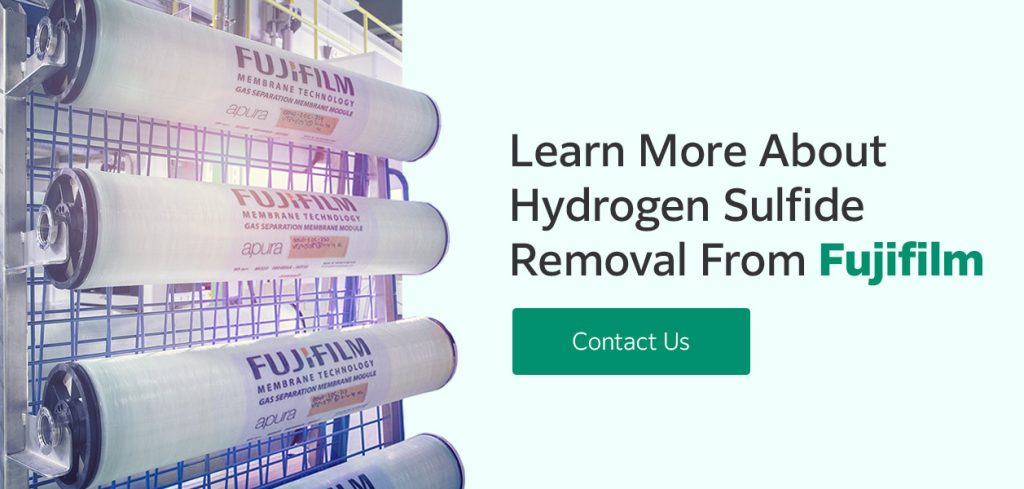
Jump to:
- What Is H2S?
- Why Does H2S Need to Be Removed From Natural Gas?
- Ways to Remove H2S From Natural Gas
- Benefits of Gas Separation Membranes
Hydrogen sulfide (H2S) is a toxic and corrosive gas. It’s found in natural gas and must be removed before the gas can be used safely. Hydrogen sulfide is removed through a process called gas sweetening. Companies use different methods to remove hydrogen sulfide from mixed gas.
Gas and oil companies are continuously looking into hydrogen sulfide removal from natural gas. Inadequate removal of this high-risk gas can lead to safety hazards to workers, equipment damage and environmental pollution. When you use an efficient method to remove it from natural gas, it improves operational efficiency, minimizes downtime for maintenance and optimizes gas quality for end-users.
What Is H2S?
Hydrogen sulfide is a colorless, toxic and flammable gas with a characteristic rotten egg smell. It is known by many names, such as dihydrogen sulfide, sulfur hydride, sulfurated hydrogen, hydrosulfuric acid, hepatic acid and sour gas. Since this naturally occurring chemical is denser than air, it often falls and accumulates at floor level or in enclosed spaces. It can also migrate into soil and groundwater.
Natural gas is considered “sour” when it contains a high percentage of hydrogen sulfide. People can detect the gas by smell at concentrations as low as 0.5 parts per billion (ppb) in the air. However, olfactory fatigue can kick in at a high concentration or at continuous exposure to low concentrations. Therefore, odor alone is not a good indicator of hydrogen sulfide accumulation.
Sources and Occurrence
You can find hydrogen sulfide in natural gas and other natural and industrial processes. Additional natural and biological sources include:
- Volcanic activity: Volcanoes release hydrogen sulfide during eruptions and geothermal activities.
- Decomposition: Bacterial breakdown of organic matter in swamps, sewage and animal waste produces hydrogen sulfide.
- Gas and oil fields: Hydrogen sulfide is naturally present in some oil and natural gas reservoirs, which can be released during extraction. Natural gas and oil refineries are the main sources of producing hydrogen sulfide as a byproduct.
- Wetlands: Microbial activity in wetland soil or stagnant water with low oxygen content can lead to the production of hydrogen sulfide.
Other occurrences of hydrogen sulfide include industrial and mining operations:
- Sewage treatment plants: Anaerobic decomposition of organic matter in sewage produces hydrogen sulfide.
- Chemical manufacturing: Certain chemical processes can generate hydrogen sulfide as a byproduct.
- Coal mines: Mining activities can sometimes release hydrogen sulfide.
- Landfills: Organic waste decomposition in landfills can produce hydrogen sulfide as a result of anaerobic conditions.
Why Does H2S Need to Be Removed From Natural Gas?
The process of hydrogen sulfide removal from natural gas is necessary as the gas can have detrimental implications in different areas. Removing hydrogen sulfide from natural gas prevents health and safety hazards, protects the environment and meets quality standards for natural gas to be transported and used safely.

Health Effects
Hydrogen sulfide’s health impact will depend on the level of exposure someone has had over a specific timeframe. It’s a highly toxic gas even in small quantities. Long-term exposure to lower concentrations could lead to chronic health challenges, while short exposure to high enough concentrations can lead to acute health effects, unconsciousness or fatalities.
The most susceptible parts of the body are the lungs and brain and those with exposed mucous membranes, such as the eyes, nose and throat. Common symptoms of exposure include:
- Respiratory irritation
- Headache
- Nausea
- Dizziness
- Fatigue
- Lowered sense of smell
- Skin complications
- Confusion
- Memory loss
- Prolonged reaction time
- Eye irritation
- Upset stomach
- Insomnia
- Irritability
- Pulmonary edema
Environmental Effects
Hydrogen sulfide tends to break down in the air without an ongoing source. It may convert to sulfur dioxide (SO2), which can combine with water vapor in the air to form sulfuric acid — a major component of acid rain. Although small amounts of hydrogen sulfide may be part of the natural environment, high concentrations without any form of ventilation may harm aquatic life and ecosystems.
Occupational Hazards
An exposure concentration of 100 parts per million (ppm) is considered immediately dangerous to life and health. Workers in wastewater treatment, agriculture, or oil and gas industries may be exposed to hydrogen sulfide with gas build-up, spills, leaks or malfunctions.
Furthermore, hydrogen sulfide is flammable and can present a fire hazard, especially in confined non-ventilated spaces. Hydrogen sulfide is also corrosive to metals. Removing it from natural gas is essential to prevent damage to equipment and structures, including pipelines, valves and storage tanks.
Ways to Remove H2S From Natural Gas
Gas sweetening is the process used to remove unwanted compounds from natural gas, such as hydrogen sulfide. Different methods exist to complete the process, but it typically involves treating natural gas with chemicals or absorbent materials to react with the impurities, thereby separating them from the gas.
Hydrogen sulfide removal methods can be classified into three categories — chemical, biological and physical. Examples include:
- Oxidation: A catalyst promotes the oxidation of hydrogen sulfide to convert it into elemental sulfur or sulfate, which are non-toxic.
- Adsorption: Activated carbon or iron compounds absorb hydrogen sulfide.
- Absorption: Water, amine or alkaline solutions react with hydrogen sulfide, dissolving it.
- Biofiltration: Sulfur-oxidizing bacteria convert hydrogen sulfide to sulfur.
- Condensation: Cooling or compression processes liquefy and separate hydrogen sulfide from natural gas.
- Membranes: Selective barriers filter hydrogen sulfide from natural gas.
Benefits of Gas Separation Membranes
Innovations in gas separation membranes continue to improve the materials and designs used for gas sweetening and fuel gas conditioning. Spiral wound membrane elements can remove carbon dioxide (CO2), hydrogen sulfide and water from natural gas. These multilayered composite membranes are robust and can easily replace conventional gas separation sites.
Membrane-based gas separation has the following benefits over conventional processes:
- Lower maintenance: Fewer moving parts require less maintenance and decrease machine downtime.
- Compact design: With a modular design, membrane systems take up less space in facilities, leaving more room for other machines.
- Cost-effective: Membrane systems can operate continuously with limited manual help and can be scaled up or down as business needs change.
- Environmentally friendly: Compared to chemical-based processes, membrane separation requires minimum chemicals, reducing potential environmental risks.
- Energy efficiency: Membranes require lower energy consumption than traditional methods like amine gas treatment.
Learn More About Acid Gas Removal From Fujifilm
Efficient hydrogen sulfide removal is important for oilfield and gas companies to explore. By investing in gas separation technologies, you can ensure a cleaner and safer natural gas facility.
For more information on how FUJIFILM Apura™ Gas Separation Membranes can effectively remove hydrogen sulfide from natural gas, contact our team online, and we’ll get back to you.














